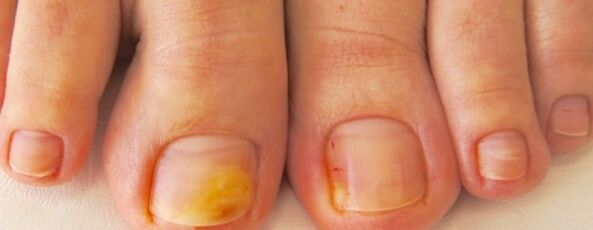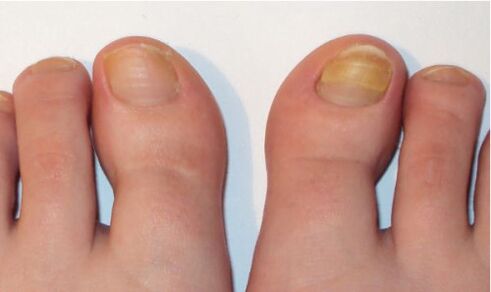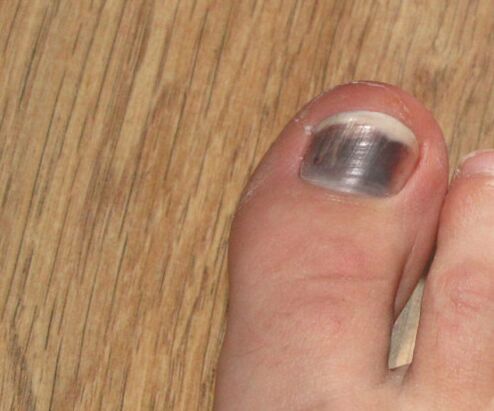Most people do not even know that the most common sweating of the feet and the unpleasant odor that accompanies it is one of the main symptoms of the development of fungal diseases. Fungus on the toenails, the symptoms of which are not immediately apparent, can be seen in anyone who does not look at himself. The disease is present almost everywhere and in most public places. The sad thing is that a fungal disease is very insidious: it is treated for a long time and is not effective in 100% of cases, because it is characterized by relapses. In order to identify the fungus in time and start treatment, you need to have an idea of how the nail fungus manifests itself.

The spread of fungal diseases
The disease is caused by the development of parasitic fungi in the body. The best conditions for their emergence and subsequent spread are a warm environment with high humidity. Many people think that it is very easy to get such an infection in water parks, baths and beauty salons.
But the statistics are completely different: you can get a fungal infection through common items (baths, clothes, shoes, towels) without leaving home. But this is true if at least one of the households is a carrier of the fungus. And yet, what in principle affects the spread of the fungus? The main causes of fungal infections are:
- Intense sweating;
- Diabetes;
- Excess weight problem;
- If the nail is damaged;
- Weak immunity.
To protect yourself from some kind of fungal infection, you should use only personal hygiene products, carry out a thorough treatment of the shower and bath, wear only your shoes, arrange the washing of rugs as often as possible, and so on. If you have already seen the first signs of nail fungus, you should contact a dermatologist immediately!
Symptoms of a fungus based on the causative agent of the disease

Signs of fungus on the toenails should be noticed in a timely manner. The effectiveness of complex treatment of fungal infections is determined by the degree to which the causative agent is correctly identified. This can be explained by the fact that there are many types of fungi and that each species reacts to a specific group of drugs.
In most cases, the cause of the disease are:
- Kif;
- Dermatophytes;
- Maya.
If the fungus begins to develop due to yeast, then it is almost impossible to detect the disease overnight. In such conditions, the symptoms of a fungus on the legs are as follows:
- Itching of the skin around the feet and nail plate;
- The nail is peeled off.
Yeast infection occurs in only 4-5% of cases. Very often they are dermatophytes affecting the nail plate (94, 5%). There are 3 types of this pathogen and the manifestation of each is very different:
- 1 type. There is a simultaneous defeat of the nail plate, the skin of the feet and toes as a whole. Such a fungus easily passes on the nails and skin of the hands.
- 2 types. The disease affects only the nails of the big toe and the little toe. It can also lead to wrinkles between the fingers.
- 3 types. It is characterized by damage to the nail plate of the little finger and thumb, but the disease does not spread to the skin.
As for the mold, the causative agent in this case are mold fungi. It is very rare. It is mainly found in AIDS patients.
Other symptoms

Often, when the disease is just beginning to develop, there are no signs of fungus on the toenails. However, if one pays too much attention to the feet, one will notice that round spots begin to appear on the nail plate, and the nail itself loses its luster and becomes rough. A developing fungal disease affects the nail plate more: it will change color first, after which the nail wears out and can break easily. The shade of the nail plate is determined by the type of pathogenic fungus.
Nail fungus: symptoms (additional)
- The nail plate becomes black;
- The nail takes an unusual shape and its structure changes completely;
- Nails are very fragile;
- Nail plastic incisions under the skin;
- Constant fatigue followed.
An abnormal appearance of the nail plate is a "call" to visit a dermatologist, where the nail fungus you are experiencing symptoms will be confirmed or denied. If you constantly delay going to the doctor, the disease will soon spread to other areas. If you do not think about it, there is nothing life-threatening in this disease. But in addition to just aesthetic problems and concerns, fungal infections are sometimes the cause of major complications. For this reason, the symptoms should not be ignored and treatment should be started in time after the disease is detected.
A doctor who treats fungal diseases
It is realistic to detect an infection yourself, but only a doctor can confirm your estimates. A dermatologist will recommend certain tests to make an accurate diagnosis. To perform them, part of the destroyed nail plate or perforation of the periungual tissue is taken.
Early detection of the infection facilitates further treatment and eliminates the possibility of complications. If treatment is not started at the right time, it will spread the disease to other organs and all the nails of the hands / feet.
Nail fungus: treatment procedure
Therapy for the treatment of the fungus is prescribed by a dermatologist - it all depends on how advanced the disease is, the type of fungus present in the body and other factors. Usually, the drug is prescribed for external use only if the fungus is just beginning to grow. In more difficult cases, seek intensive care.
By the way, this takes a lot of time. Therefore, it is in your interest to consult a doctor with the slightest suspicion of a fungal infection! Symptoms of nail fungus should be recognized in advance. And the sooner the disease is detected, the sooner the treatment will happen!





























